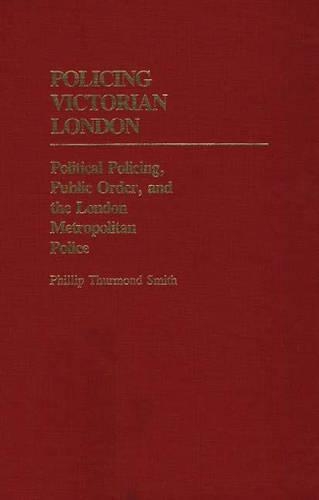
Policing Victorian London: Political Policing, Public Order, and the London Metropolitan Police
(Hardback)
Publishing Details
Policing Victorian London: Political Policing, Public Order, and the London Metropolitan Police
By (Author) Phillip Smith
Bloomsbury Publishing PLC
Praeger Publishers Inc
22nd March 1985
United States
Classifications
Tertiary Education
Non Fiction
Police and security services
European history
363.209421
Physical Properties
Hardback
242
Width 140mm, Height 216mm
454g
Reviews
Phillip Thurmond Smith studies the other side of the public order question by tackling the history of Peel's Metropolitan Police force (1830-60). Smith's work is not as scholarly or astute as the two previous contributions although he gleans much interesting material from his study of the Metropolitan Police Records and the Home Office Records. The discussion of the police surveillance of the Great Exhibition is particularly interesting. Smith is safest when discussing police policy, tactics, and history and less sure when generalizing about nineteenth-century society as a whole. His treatment of the Sunday Trading Riots of 1855, the Garibaldi Riots of 1865, and the Hyde Park Riots of 1866-7 is informative.-The Year's Work in English Studies
Smith's book is a welcome addition to the literature on crime and police history. It is a beautifully organized, readable, and succinct account of the Metropolitan Police from 1829 to 1868.... Smith discusses the evolution of the police idea, the inner workings and leadership of the force, and the other side of policing'--detection, surveillance, aliens, and threats to security. The chief value of this study, however, is the author's emphasis upon the police in regard to public order and political policing, ' i.e., police control of, or surveillance of, dissident or disaffected citizens to protect the interests or power of the government.' Public disorder was much a part of Regency and Victorian London; and Smith, using major disturbances in Mid-Victorian Britain as his case studies, traces the development by the police (mainly through trial and error) of effective crowd control. Smith also nicely relates his work to the social history of the era. ... Recommended for undergraduate, graduate, and public libraries.-Choice
"Phillip Thurmond Smith studies the other side of the public order question by tackling the history of Peel's Metropolitan Police force (1830-60). Smith's work is not as scholarly or astute as the two previous contributions although he gleans much interesting material from his study of the Metropolitan Police Records and the Home Office Records. The discussion of the police surveillance of the Great Exhibition is particularly interesting. Smith is safest when discussing police policy, tactics, and history and less sure when generalizing about nineteenth-century society as a whole. His treatment of the Sunday Trading Riots of 1855, the Garibaldi Riots of 1865, and the Hyde Park Riots of 1866-7 is informative."-The Year's Work in English Studies
"Smith's book is a welcome addition to the literature on crime and police history. It is a beautifully organized, readable, and succinct account of the Metropolitan Police from 1829 to 1868.... Smith discusses the evolution of the police idea, the inner workings and leadership of the force, and the other side of policing'--detection, surveillance, aliens, and threats to security. The chief value of this study, however, is the author's emphasis upon the police in regard to public order and political policing, ' i.e., police control of, or surveillance of, dissident or disaffected citizens to protect the interests or power of the government.' Public disorder was much a part of Regency and Victorian London; and Smith, using major disturbances in Mid-Victorian Britain as his case studies, traces the development by the police (mainly through trial and error) of effective crowd control. Smith also nicely relates his work to the social history of the era. ... Recommended for undergraduate, graduate, and public libraries."-Choice
Author Bio
ith /f Phillip /i Thurmond
